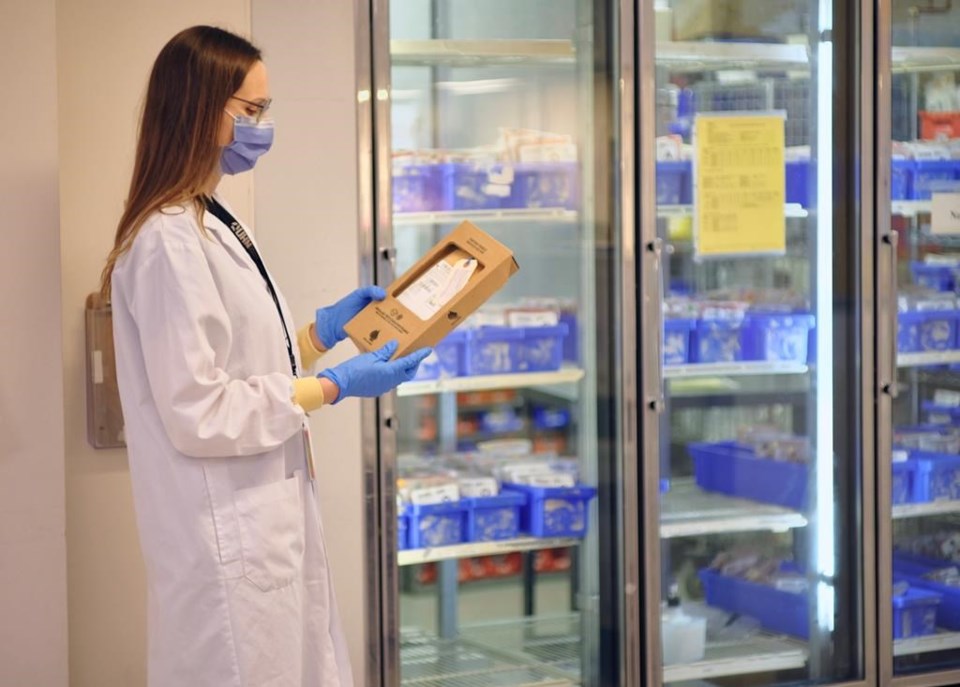TORONTO — The first two COVID-19 patients in Canada to receive plasma transfusions rich in antibodies are showing signs of improvement as the experimental treatment expands to trials in more than a dozen sites in Ontario and Quebec.
A senior media adviser for CHU Sainte-Justine hospital in Montreal says the outlook is "favourable" for a female patient who was the first to receive a transfusion May 15, noting she has been released from intensive care.
Meanwhile, a 78-year-old man who received the second transfusion May 22 at University Health Network's Toronto General Hospital was expected to make a full recovery, says his physician, Dr. David Hwang.
The patients are part of a controlled, randomized trial that is testing whether a transfusion of plasma donated by recovered COVID-19 patients can reduce deaths and speed up recovery.
The hope is that the influx of another person's antibodies will help an infected patient battle COVID-19 until their body can develop its own virus-fighting antibodies.
At least five patients had received transfusions by Wednesday, with more joining the trial daily. Researchers hope to study 1,200 participants in about 60 medical centres, 800 of whom will receive transfusions while 400 will be part of a control group that gets no transfusion.
A lead scientist for the CONCOR-1 study, Dr. Jeannie Callum of Toronto's Sunnybrook Health Sciences Centre, says the trial will be expanded to at least 20 hospitals by the weekend, most of them in Ontario but including a handful in Quebec, and three in New York City.
Callum, director of utilization for the department of laboratory medicine and molecular diagnostics, says researchers are targeting hospitals "with the highest activity" of COVID-19 cases.
"We're going to have one to two (trial participants) per day for the next two weeks. And then past that point we're going to be above our target which is to have three patients per day," says Callum, estimating it will take six months to study 1,200 patients.
Hwang says his patient was admitted two weeks ago for issues related to dementia but was tested and diagnosed with COVID-19.
The patient displayed no respiratory symptoms but breathing trouble emerged late last week, and he soon required an increasing amount of supplemental oxygen, says Hwang.
The need for oxygen also qualified the senior for the trial, says Hwang, and the man was quickly enrolled and randomly chosen for a transfusion the same day, a speedy progression Hwang chalks up to "a little bit of luck."
"We were preparing for things to worsen even further," says Hwang, a specialist in internal medicine.
"Some people plateau off, but there was no reason to believe that he was going to manage this himself. He's 78-years-old, he's a frail man."
Since then, the man's breathing has improved, although he still required some supplemental oxygen this week, says Hwang.
Dr. Christine Cserti, transfusion medicine specialist at University Health Network, outlined a massive co-ordinated effort to design and implement the trial in mere weeks as a global pandemic ravages many parts of the world, stifles economies and stretches health-care resources.
"What I saw on Friday, it just warmed me to no end," Cserti says of seeing the work culminate in Toronto's first COVID-19 plasma transfusion.
"People really just want this to work."
Of course, the use of convalescent plasma to treat an illness is not new. Among the ailments it has been used for is the 1918 influenza outbreak — also known as the Spanish flu.
Callum says somewhere between five and eight per cent of people admitted to hospital get plasma for other reasons, and it's generally considered a safe procedure.
Cserti allows there's a "one to 10 per cent chance of a transfusion reaction," but that getting something like COVID-19, HIV, Hepatitis B or West Nile virus from a transfusion is "like being struck by lightning."
"These are things we all do sophisticated testing for," she says. "We feel really reassured about our blood supply."
A more serious complication is a lung injury called TRALI or transfusion-related acute lung injury, in which air sacs are flooded with fluid but Cserti pegs the chance of that happening at "one in 1,000 to one in 100,000."
If the trial is successful, there would be several challenges to employing plasma transfusions as a standard approach to treating COVID-19.
Callum notes it would require a significant increase in plasma donations, which must come from those younger than 67 who have fully recovered from COVID-19 and are symptom-free for at least 28 days.
"That would compete for slots for people to donate platelets that we need for people that have acute leukemia or cardiac surgery," says Callum. "So, we need to know it works."
Cserti notes there are cases where a plasma transfusion hasn't helped a COVID-19 patient, and although a much-touted U.S. COVID-19 trial involving 5,000 transfusion subjects suggested the approach was safe, it did not have a control group like this smaller Canadian-led study.
"There's always flash and pizzazz on early anecdotes, right?" says Cserti.
"Everybody says: 'Oh, this works so well,' and it's not until you get a control group chugging alongside that you say, 'OK, maybe this isn't that much better.'"
Hwang is optimistic there are benefits, noting the transfusion appears to reduce the time needed on supplemental oxygen and may allow a patient to get out of bed earlier.
But he doesn't expect it to be the treatment that will take down COVID-19.
"It's very resource-intensive. You need to get donors and go through this lengthy process just to get one unit of plasma. And, it's not even a preventive measure. It's just (something that is) modulating the disease or augmenting the trajectory of it," he says.
"I don't think this is going to be our answer to COVID, but it might be what will save some lives down the road."
This report by The Canadian Press was first published May 28, 2020.
Cassandra Szklarski, The Canadian Press
